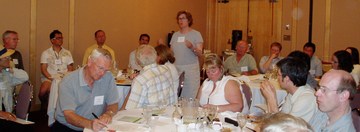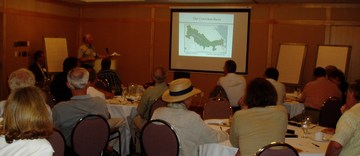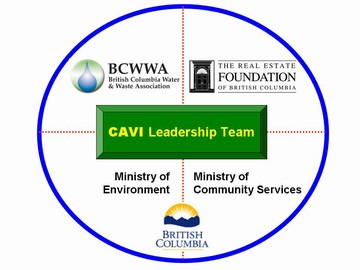Vancouver Island Local Governments Share Success Stories at ‘Creating Our Future Workshop'
The Creating Our Future Workshop, held on June 3rd as a shoulder event to the Gaining Ground Summit Conference in Victoria, was high energy from start to finish and achieved its objective of celebrating Vancouver Island success stories. This sets the stage for building on success to move Green Value from concept to practice.
Hosted by the Real Estate Foundation of British Columbia under the umbrella of the CAVI-Convening for Action on Vancouver Island partnership, the workshop was by invitation. Attendance was capped at 50.
Held on a Sunday, this alone demonstrated the interest and commitment of those who attended. The event attracted elected officials and senior managers from 19 local governments; and a balanced mix of representatives from provincial ministries, First Nations, the private sector, the real estate industry, and academia.

Workshop Progam
For an overview of the workshop program and to access the set of workshop presentations, as well as to access links to other stories about Creating Our Future, please click here. Designed to inform decision-makers in local government, the workshop was structured in three parts:
1. Defining a common vocabulary
2. Roundtable sharing
3. Convening for Action on Vancouver Island case studies
The following story provides a ’50,000 foot view’ of some of the ‘on the ground’ initiatives taking place across Vancouver Island municipalities and Regional Districts. These examples clearly demonstrate that paying attention to water  sustainability is moving into mainstream municipal/regional district thinking – and most importantly – action. As Paul Hawken, the keynote speaker at the Gaining Ground Summit Conference mentioned after dropping by the water sustainability workshop, “I was impressed with the energy in the room and the focus on concrete action.”
sustainability is moving into mainstream municipal/regional district thinking – and most importantly – action. As Paul Hawken, the keynote speaker at the Gaining Ground Summit Conference mentioned after dropping by the water sustainability workshop, “I was impressed with the energy in the room and the focus on concrete action.”
Paul Hawken has spent over a decade researching organizations dedicated to restoring the environment and fostering social justice. Paul heads the Natural Capital Institute, a research group located in Sausalito, California.

Roundtable Sharing
It is noteworthy that without exception these projects combine innovative thinking, a willingness to risk new approaches, collaboration on the part of governments, developers, industry and communities, and last but far from least, a win-win solution which benefits all the stakeholders. In many cases they also take advantage of opportunities to educate the public.
- Oliver Brandes, the team leader for the Water Sustainability Project at
 the Uniiversity of Victoria’s POLIS Project on Ecological Governance, indicated that the Capital Regional District is very focused on ‘living within the means’ of the existing reservoir – that is, offsetting growth with innovative conservation measures. There is currently a widely supported motion before Council to this effect. The challenge will be getting staff, politicians and the public to understand the issues and opportunities this goal presents.
the Uniiversity of Victoria’s POLIS Project on Ecological Governance, indicated that the Capital Regional District is very focused on ‘living within the means’ of the existing reservoir – that is, offsetting growth with innovative conservation measures. There is currently a widely supported motion before Council to this effect. The challenge will be getting staff, politicians and the public to understand the issues and opportunities this goal presents. - Barry Avis, a Councillor in the Town of Qualicum Beach, reported that the
 town has an 87-acre property which includes the Cook Creek estuary at Cook Bay. They are working with the Nature Trust organization and other groups to develop an innovative model Official Community Plan that will ensure ‘water sustainable’ future development. Barry also reported that one new development located about 20 miles west of Qualicum Beach has incorporated a number of initiatives such as no curbs, bioswales and rain gardens. The town has now passed new bylaws supporting the above for future development. He was very pleased to report that use of these measures has created an attractive environment resulting in higher property values (which is consistent with an Australian case study that reported a 7% to 15% premium for properties next to green space).
town has an 87-acre property which includes the Cook Creek estuary at Cook Bay. They are working with the Nature Trust organization and other groups to develop an innovative model Official Community Plan that will ensure ‘water sustainable’ future development. Barry also reported that one new development located about 20 miles west of Qualicum Beach has incorporated a number of initiatives such as no curbs, bioswales and rain gardens. The town has now passed new bylaws supporting the above for future development. He was very pleased to report that use of these measures has created an attractive environment resulting in higher property values (which is consistent with an Australian case study that reported a 7% to 15% premium for properties next to green space). - Chris Jensen, BC Ministry of Community Services said that a master drainage plan for Bowker Creek has estimated that some $21M to $31M wort
 h of upgrades would be required to meet municipal standards for flood prevention. Limiting the creation of more impervious surfaces in the watershed is key to minimizing the costs of required upgrades. The plan shows a clear link between the infrastructure costs of traditional development verses the downstream savings of using low impact development. The Bower Creek plan is an initiative of the Capital Regional District and three member municipalities. The plan evaluated several scenarios, some of which also prepared for expected changes in precipitation patterns due to climate change. The preferred option recommends daylighting several sections of this urban creek
h of upgrades would be required to meet municipal standards for flood prevention. Limiting the creation of more impervious surfaces in the watershed is key to minimizing the costs of required upgrades. The plan shows a clear link between the infrastructure costs of traditional development verses the downstream savings of using low impact development. The Bower Creek plan is an initiative of the Capital Regional District and three member municipalities. The plan evaluated several scenarios, some of which also prepared for expected changes in precipitation patterns due to climate change. The preferred option recommends daylighting several sections of this urban creek  Patrick Lucey, Aqua-Tex Scientific Consulting Ltd., went on to say that aspart of the Hillside Mall re-development, there has been consideration of daylighting approximately 1.5 kilometers of Bowker Creek. Interestingly, it is anticipated that in addition to saving money in new drainage infrastructure, this approach will also provide several benefits including improved water quality, creation of a new community asset, and increased property values along the newly exposed creek.
Patrick Lucey, Aqua-Tex Scientific Consulting Ltd., went on to say that aspart of the Hillside Mall re-development, there has been consideration of daylighting approximately 1.5 kilometers of Bowker Creek. Interestingly, it is anticipated that in addition to saving money in new drainage infrastructure, this approach will also provide several benefits including improved water quality, creation of a new community asset, and increased property values along the newly exposed creek.- Corri Barraclough, Aqua-Tex Scientific Consulting, added her experience
 with the daylighting of a portion of the Mt. Dove creek (which brought salmon back) and the Blenkinsop creek (which led to increased esthetic, ecological and community values). As a result of these successful precedents, the Ministry of Environment and the Department of Fisheries and Oceans are now fast-tracking viable creek daylighting projects.
with the daylighting of a portion of the Mt. Dove creek (which brought salmon back) and the Blenkinsop creek (which led to increased esthetic, ecological and community values). As a result of these successful precedents, the Ministry of Environment and the Department of Fisheries and Oceans are now fast-tracking viable creek daylighting projects. - Chris Corps of Asset Strategics Ltd., reported that Thetis Cove, is going to
 be remediated and the riparian zones rehabilitated. A developer is investing the $1M required to do this, with benefits to development value, Esquimalt Nation and in making the foreshore accessible to the community.
be remediated and the riparian zones rehabilitated. A developer is investing the $1M required to do this, with benefits to development value, Esquimalt Nation and in making the foreshore accessible to the community. - Kevin Lagan, City of Courtenay, indicated that the year long development permit process for a large Home Depot, located near the headwaters of a sensitive drainage system, led to the implementation of British Columbia’s
 first deep-well injection system for returning rainwater runoff to the ground In addition, Home Depot will be required to conduct environmental monitoring for 5 years. Other benefits include reduced downstream flooding, aquifer recharge, an estimatged $1M savings in traditional stormwater management systems and finally, considerable community good will. John Manson, CAVI member and City Engineer for Langford, indicated that there is a similar project underway in the Township of Langley, which will be showcased across the Lower Mainland.
first deep-well injection system for returning rainwater runoff to the ground In addition, Home Depot will be required to conduct environmental monitoring for 5 years. Other benefits include reduced downstream flooding, aquifer recharge, an estimatged $1M savings in traditional stormwater management systems and finally, considerable community good will. John Manson, CAVI member and City Engineer for Langford, indicated that there is a similar project underway in the Township of Langley, which will be showcased across the Lower Mainland. - Graeme Faris, Comox-Strathcona Regional District, elaborated on Home Depot example by describing the innovative design of the water supply and fire protection system that serves the surrounding commercial area. This design saved everyone money while reducing greenhouse gases.
- He went on to say that the Regional District has just completed the Comox
 Lake Watershed Assessment, the first to be completed pursuant to the Province’s new ‘Comprehensive Drinking Water Source to Tap Assessment Guideline’. This process included significant community involvement. The Region took this opportunity to educate people about the value of water and the importance of conservation. The result was increased public demand for water metering.
Lake Watershed Assessment, the first to be completed pursuant to the Province’s new ‘Comprehensive Drinking Water Source to Tap Assessment Guideline’. This process included significant community involvement. The Region took this opportunity to educate people about the value of water and the importance of conservation. The result was increased public demand for water metering. - At this point Oliver Brandes shared discussion at a recent conference in Albuquerque, New Mexico. People are now debating who ‘owns’ wastewater. The perception of wastewater has gone from being a cost of doing business to a valuable resource which can facilitate green development.

- Brigid Reynolds and Peter Nilsen, District of North Cowichan, described a proposed 52-acre project in Chemainus. This is on municipally-owned land within a designated growth area and potentially could have been a 150-
 lot project. However, this plan was controversial because residents had used the property as a walking area for many years, but more importantly because of the environmentally sensitive features on the property. After much discussion with residents, it was determined that fifty percent of the land will be retained as park/ walking trails – primarily because of the environmentally sensitive areas; the remainder will be developed using on-site water treatment, geo-therma
lot project. However, this plan was controversial because residents had used the property as a walking area for many years, but more importantly because of the environmentally sensitive features on the property. After much discussion with residents, it was determined that fifty percent of the land will be retained as park/ walking trails – primarily because of the environmentally sensitive areas; the remainder will be developed using on-site water treatment, geo-therma l heat, rainwater management source controls (including green roofs, infiltration galleries, and rain gardens). Riparian buffer zones will be retained. In addition, carriage houses and other affordable housing options will be included in the development. The municipality can do this because it owns the land. The broader goal, however, is to demonstrate to private developers what is possible.
l heat, rainwater management source controls (including green roofs, infiltration galleries, and rain gardens). Riparian buffer zones will be retained. In addition, carriage houses and other affordable housing options will be included in the development. The municipality can do this because it owns the land. The broader goal, however, is to demonstrate to private developers what is possible. - John Finnie, CAVI Chair and General Manager, Environmental Services with the Regional District of Nanaimo (RDN), reported that his organization
 recognized that they had an opportunity to do something different in conjunction with future expansion and upgrading of their Greater Nanaimo wastewater treatment plant. The site was constrained by existing buildings and a buried creek. Their creative solution was to purchase adjacent properties and remove the buildings, and regrettably, a neighbourhood pub. This enabled the RDN to redesign the creek bed, daylighting selected portions. The RDN will be collaborating with the City of Nanaimo about walking trails on the property and is working with the Department of Fisheries and Oceans to restore fish habitat. Finally, the RDN is considering a public education signage strategy.
recognized that they had an opportunity to do something different in conjunction with future expansion and upgrading of their Greater Nanaimo wastewater treatment plant. The site was constrained by existing buildings and a buried creek. Their creative solution was to purchase adjacent properties and remove the buildings, and regrettably, a neighbourhood pub. This enabled the RDN to redesign the creek bed, daylighting selected portions. The RDN will be collaborating with the City of Nanaimo about walking trails on the property and is working with the Department of Fisheries and Oceans to restore fish habitat. Finally, the RDN is considering a public education signage strategy.

Showcasing Green Infrastructure Innovation
The Creating Our Future Workshop provided the CAVI Partnership with a timely opportunity to announce that it is collaborating with three regional districts and member municipalities to present Showcasing Green Infrastructure Innovation on Vancouver Island: The Series.
 According to Kim Stephens, Program Coordinator for the Water Sustainability Action Plan, “The purpose of the Showcasing Innovation Series is to celebrate…and build on….the on-the-ground successes that are enhancing the ways communities are being developed and water is being managed.”
According to Kim Stephens, Program Coordinator for the Water Sustainability Action Plan, “The purpose of the Showcasing Innovation Series is to celebrate…and build on….the on-the-ground successes that are enhancing the ways communities are being developed and water is being managed.”
“The goal is to promote networking, build regional capacity, and ‘move from awareness to action’ — through sharing of approaches, tools, experiences and lessons learned”, Stephens added, “Each of the three events in the Showcasing Innovation Series will comprise presentations in the mornings and a tour of project sites in the afternoon.”
The Showcasing Innovation Series is scheduled for the September/October period. Events will be on Fridays at two-week intervals.For more infornation.
CAVI Partnership
The CAVI Partnership includes the British Columbia Water & Waste Association, the Real Estate Foundation of British Columbia, the provincial Ministries of Environment and Community Services, and the Green Infrastructure Partnership.
 According to CAVI Chair John Finnie, “If we are to control our destiny and create our future, then we need to challenge our fellow Vancouver Islanders to visualize what they want Vancouver Island to look like in 50 years. We have identified two desired outcomes in Convening for Action. First, we wish to influence Vancouver Island local governments to adopt Design with Nature as the preferred process of approving land development applications. Secondly, we intend to facilitate the move from awareness to action in changing the way that land is developed and water is used on Vancouver Island.”
According to CAVI Chair John Finnie, “If we are to control our destiny and create our future, then we need to challenge our fellow Vancouver Islanders to visualize what they want Vancouver Island to look like in 50 years. We have identified two desired outcomes in Convening for Action. First, we wish to influence Vancouver Island local governments to adopt Design with Nature as the preferred process of approving land development applications. Secondly, we intend to facilitate the move from awareness to action in changing the way that land is developed and water is used on Vancouver Island.”

Posted June 2007



